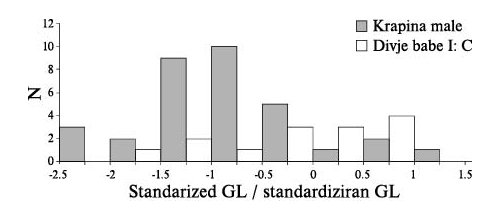 Institute of Archaeology Institute of Archaeology |
[Slovenian] |
| Home | Members | Programme | Projects | Laboratory |
| Database | Publications | Library | Links | Archive |
|
FRAGMENTS OF ICE AGE ENVIRONMENTS Sex and Size of the Krapina Cave Bears Preston T MIRACLE
Abstract Krapina, world-famous for its large and variable Neandertal fossils, is also a key site for examining Neandertal lifeways and environments during the last interglacial period (MI S 5e) approximately 130,000 ka. The largest sample of vertebrates at Krapina comes from the cave bear (Ursus spelaeus). This study presents a detailed analysis of the sex structure of the Krapina cave bear assemblage and compares it to other sites in the region. The Krapina cave bear assemblage is overwhelmingly dominated by males (frequency of males from 63.6–100%, depending on the element analysed), and the male bias is found in the head, teeth, and major limb bones. Krapina was primarily used by prime-aged to old-adult male cave bears, once the rockshelter had mostly filled with sediment eroded from the shelter roof and wall (Miracle 2007). Contrasts in body size between Krapina and nearby sites, after sexual dimorphism is taken into account, are significant and striking. The Krapina male cave bears are smaller than male cave bears from Divje babe facies A (MIS 3) and Divje babe facies C (MIS 5a-d). The small size of the Krapina male cave bears is best understood as an adaptation to a full, interglacial climate. These results suggest that Krapina’s stratigraphy extended neither into later substages of the last interglacial (e.g. MIS 5a-d) nor into the last glacial (MIS 3–4). Temporal changes at Krapina in subsistence activities, stone tool production, and site use (Miracle 2007) occurred over a relatively short time period; Neandertals were behaviourally flexible and shifted their activities and strategies in response to local conditions and opportunities. Keywords: Krapina, Divje babe, cave bear, Pleistocene, sexual dimorphism, body size, Croatia, Slovenia, palaeontology *** 2011, (Opera Instituti Archaeologici Sloveniae, 21), 280 pages, 44 b-w photographs, 10 drawings, 52 tables, 71 graphs and 9 maps, 20 x 29 cm hardcover, ISBN 978-961-254-257-3. |
